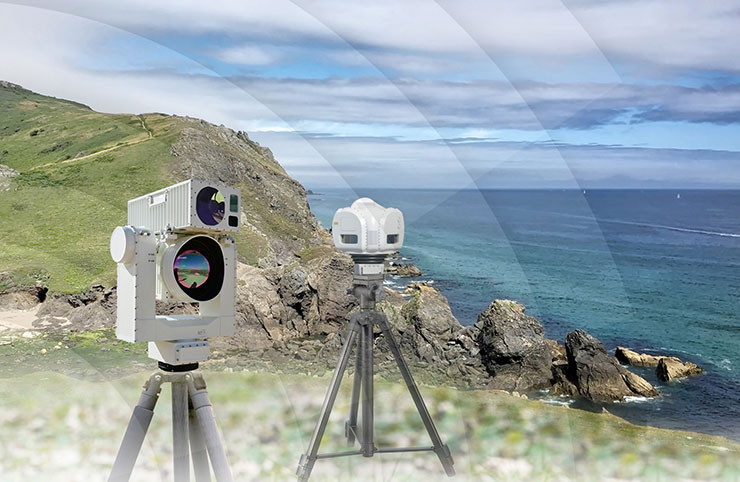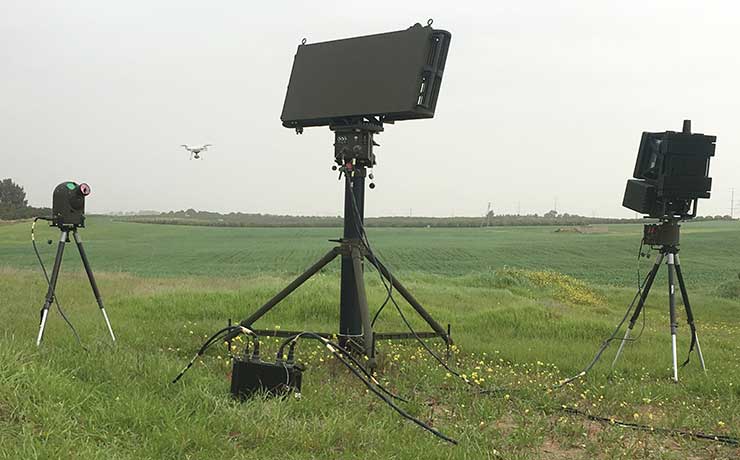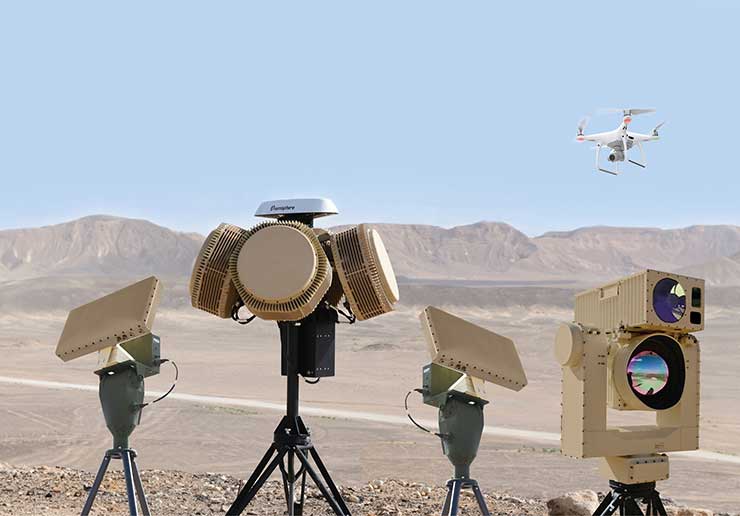
Since the outbreak of the conflict with the Hamas in the Gaza Strip on October 7, 2023, the Israeli Defence Forces (IDF) have heightened their concern regarding the threat posed by armed drones. Notably, the Hezbollah in Lebanon, acting as an Iranian proxy, has employed armed drones to target villages, cities, and military bases in Northern Israel throughout the duration of the war. Israeli air defence systems, along with fighter aircraft, have successfully intercepted these attacks, preventing any significant damage.
Simultaneously, the Houthi rebels in Yemen, also affiliated with Iran, attempted to use armed drones to strike targets in Southern Israel. However, the IDF effectively thwarted these attempts, shooting down the drones and averting potential harm.
In recent months, Iran has significantly increased the production of armed drones, distributing them not only to their main client, the Russian forces involved in the conflict in Ukraine, but also to their proxies in the Middle East and Gulf regions. The recipients include Hezbollah in Lebanon, the Houthi rebels in Yemen, and certain affiliated terror groups in Syria. This surge in drone production underscores Iran’s broader strategy of providing advanced military technology to its allies and proxies, escalating tensions in the region.
A notable feature of the Drone Guard system is its integrated multi-layered sensor system. This includes a 3D X-band radar capable of detecting and tracking various drone types, a dedicated COMINT system for classifying drones based on their transmissions (thus verifying the target and reducing false detection rates), an Electro-Optical/Infrared (EO/IR) camera for classifying detected objects, and a jammer to neutralise and intercept the threatening object
Rising Aerial Threats
Israel, recognising the emerging threat posed by armed Unmanned Aerial Vehicles (UAVs) and drones, has proactively developed numerous defence systems to counter this evolving danger. The utilisation of Iranian-manufactured armed drones by Russian forces in the Ukraine conflict is deemed by Israeli experts as a foreseen development within the escalating trend of employing armed UAVs and drones in warfare.
Following the Houthi rebels’ attack on Saudi Arabia’s oil facilities in 2019, Iran thoroughly examined the outcomes and implemented enhancements to its armed drone technology. This particular assault involved a combination of cruise missiles and armed drones. In recent months, the Houthi rebels have received multiple shipments of these upgraded drone versions.

In times of war, Israel possesses a comprehensive toolbox to effectively address the armed drone threat. This arsenal includes interception capabilities through air defence systems or fighter aircraft. However, the menace posed by armed drones extends beyond wartime scenarios, permeating into peacetime or what Israel terms the “war between wars.” The armed drones utilised during conflicts are typically intercepted, but the danger persists in everyday situations. Terror groups exploit these cost-effective weapon systems to carry out attacks on civilian targets, including large gatherings of people and critical civil installations.
This underscores the need for ongoing vigilance and preparedness, as armed drones present a constant and formidable challenge in both wartime and peacetime scenarios. Israel’s proactive stance in developing defence mechanisms reflects a strategic commitment to addressing this persistent threat and ensuring the safety of its civilian population.
Countering the Threats
In response to the imminent threat posed by armed UAVs and drones, the Israeli Ministry of Defence, in collaboration with Israeli defence companies, has undertaken extensive efforts to identify and implement the most effective solutions. The gravity of the threat posed by armed UAVs and drones is being earnestly acknowledged not only by Israel but also by various countries globally.
Rafael Advanced Defense Systems, a prominent Israeli defence company, has actively contributed to the ongoing efforts to address the increasingly diverse threat landscape by developing the Drone Dome. This cutting-edge system combines radar and laser-beam technologies to detect and destroy drones, with the company leveraging its existing laser systems to effectively counter the drone threat
However, a new and rapidly emerging threat is capturing attention – the potential for attacks by swarms of armed UAVs. This menace was starkly highlighted in 2018 when the Russian Ministry of Defence reported an unprecedented incident in Syria where their forces were attacked by a swarm of homemade drones. This marked the first instance of a coordinated assault involving a swarm of drones in a military action.
Given the escalating threats, particularly the numerous attempts to cause casualties in Israel using armed UAVs and drones, the nation has initiated a comprehensive and multifaceted effort. This concerted approach has spurred numerous Israeli companies to develop cutting-edge defence systems explicitly designed to detect, neutralise, or destroy incoming UAVs and drones.

Innovative Anti-Drone Systems
The unique challenges presented by UAVs and drones distinguish them from traditional airborne threats, such as missiles or warplanes. This necessitates innovative and specialised defence solutions capable of effectively countering the distinctive characteristics and tactics employed by these unmanned aerial threats.
Elta, the electronics group of the Israel Aerospace Industries (IAI), has developed the Drone Guard to effectively counter the threat posed by UAVs and drones. This sophisticated system is designed to detect and block the communication capabilities of hostile UAVs without compromising the communication infrastructure of nearby civilian installations. By disrupting and neutralising the operation of the hostile UAV or drone, the Drone Guard enhances security measures.
The Drone Guard system relies on a combination of advanced technologies, including 3D radars for tracing air targets, electro-optical and Communication Intelligence (COMINT) means, and a dedicated UAV flight disruption system. Elta highlights that the Drone Guard has proven successful in countering a variety of UAVs and drones, adapting to different scenarios such as forays or multiple-target engagements.
A notable feature of the Drone Guard system is its integrated multi-layered sensor system. This includes a 3D X-band radar capable of detecting and tracking various drone types, a dedicated COMINT system for classifying drones based on their transmissions (thus verifying the target and reducing false detection rates), an Electro-Optical/Infrared (EO/IR) camera for classifying detected objects, and a jammer to neutralise and intercept the threatening object.
The ReDrone system, as highlighted by Elbit Systems, leverages advanced and field-proven Signals Intelligence (SIGINT) and Electronic Warfare (EW) technologies, creating a comprehensive two-level solution that caters to both short and long-range protection needs
The unified command and control unit manage all the sensors, offering a cohesive and efficient response to potential threats. The layered configuration of the system provides added protection, ensuring continued effectiveness even if one layer experiences a failure. Elta emphasises that the Drone Guard system excels in “closing the cycle” rapidly, neutralising threats swiftly through the utilisation of various sensors that deliver highly accurate detection, identification, and precise location information for the different active systems employed to neutralise the threat.
Rafael Advanced Defense Systems, a prominent Israeli defence company, has actively contributed to the ongoing efforts to address the increasingly diverse threat landscape by developing the Drone Dome. This cutting-edge system combines radar and laser-beam technologies to detect and destroy drones, with the company leveraging its existing laser systems to effectively counter the drone threat. The Drone Dome’s functionality involves radar identification of targets, followed by the destruction of these identified targets through the deployment of its laser system. Furthermore, the system incorporates a jamming component designed to disrupt communications between the drone and its operator.
The Drone Dome boasts an impressive operational range, extending over several miles, while minimising disruptions to other systems in urban areas located in close proximity. To neutralise the drone threat, the system activates directional Global Positioning System/Global Navigation Satellite System (GPS/GNSS) and radio-frequency inhibitor/jammer devices. Importantly, the inclusion of a laser weapon is optional, providing flexibility based on specific operational requirements.

During a recent demonstration conducted in Israel, Rafael’s Drone Dome showcased its capabilities by successfully intercepting multiple drones, including manoeuvring targets, using its hard-kill laser beam. The company reports a 100 per cent success rate in all test scenarios, highlighting the system’s proficiency in various stages of interception, including target detection, identification, and the application of a high-power laser beam for interception.
Elbit Systems has contributed to the anti-drone capabilities with its development of the ReDrone system. According to the company, ReDrone is designed to detect, identify, locate, and neutralise commercial drone threats in real-time, offering highly effective countermeasures suitable for civilian, Homeland Security (HLS), military, and paramilitary defence applications.
The ReDrone system, as highlighted by Elbit Systems, leverages advanced and field-proven Signals Intelligence (SIGINT) and Electronic Warfare (EW) technologies, creating a comprehensive two-level solution that caters to both short and long-range protection needs. This versatility positions the ReDrone system as an ideal choice for various scenarios, including border defence, airport security, and protection of strategic facilities, securing public events, safeguarding convoys, and ensuring the safety of VIPs.
Key features of the ReDrone system include its 360° coverage, enabling it to detect and defeat single or multiple drones simultaneously. Operating as a passive system with reactive jamming capabilities, the ReDrone system only transmits signals when a drone is detected. Upon detection, an automatic alert is generated, triggering the process of neutralising the drone’s navigation and communication capabilities.
The ReDrone system’s integration of advanced technologies, coupled with its adaptability to diverse operational scenarios, underscores its significance in addressing the evolving challenges presented by the proliferation of commercial drones. Elbit Systems continues to contribute to the enhancement of Israel’s defence capabilities, ensuring the nation’s preparedness and resilience against emerging threats in various defence and security domains.
Advancements in Anti-Drone Technology
The advancement of anti-UAV/drone systems is undergoing a significant transformation, primarily driven by the increasing potency of laser systems. Current laser systems are effective in eliminating small drones or UAVs from relatively short ranges and altitudes. The ongoing effort in this field is focused on integrating more powerful lasers into these systems, aiming to achieve positive kills even against larger drones and UAVs.
Elbit Systems, a key player in the defence industry, has been selected by the Israeli Ministry of Defence to provide an aerial laser-based solution to protect Israel from missiles and rockets. This initiative is supplementary to the operational Iron Dome systems manufactured by Rafael. Elbit anticipates that laser technology will be a key growth engine in the coming years, citing a technological breakthrough that enables the construction of an operational system if funded by the defence ministry.

Simultaneously, Rafael is developing the Iron Beam, a ground-based laser system designed to destroy aerial threats like armed UAVs and armed drones.
As reported by Raksha Anirveda, the prototype of the Iron Beam has been deployed for advanced testing near the Gaza strip during the ongoing war. Two years ago, after a long “war” between the proponents and opponents of a laser based defence systems, the program officially started.
Sources say that the initial effort is to develop an electric 100-150 kW solid state laser that is capable of intercepting rockets and missiles. The idea is to use two laser guns to create the needed power.
“In order to have a system capable of intercepting more than short range rockets and missiles, Israel will need a laser generator with the capability of producing 1 MW beam,” a source in the defence industry added.
Elbit Systems, a key player in the defence industry, has been selected by the Israeli Ministry of Defence to provide a laser-based solution to protect Israel from missiles and rockets. This initiative is supplementary to the operational Iron Dome systems manufactured by Rafael
Global Interest in Israeli systems
The global spread of threats has prompted South Korea to explore the acquisition of Israeli-made anti-drone systems. This decision comes in response to recent incursions by North Korean drones into South Korean airspace. Rafael’s Sky Spotter is the first system under consideration, known for its capability to detect small drones. Using a network of sophisticated optical sensors, Sky Spotter employs radar countermeasures to locate small targets or aircraft. The system utilises artificial intelligence to distinguish and classify objects, enhancing its accuracy and reliability.
Sky Spotter, described as a cutting-edge passive early warning electro-optical (EO) sensor, plays a crucial role in standalone Air Surveillance and Warning (AS&W) systems for force protection, air situational awareness, and support for Counter-Unmanned Aerial Systems/Ground-Based Air Defence (C-UAS/GBAD) systems. Its wide-field-of-view staring sensor continuously monitors the airspace, automatically detecting and tracking multiple targets while providing a sense-and-warn function.
In addition to passive detection systems, South Korea may evaluate Israeli systems designed to actively counter hostile UAVs and drones. According to a company source, upgrades to the Drone Dome have introduced game-changing features, extending its maximum detection range to 150 km using the SIGINT sensor. The system’s jamming capabilities can be deployed within a range of 50 km. These enhancements significantly elevate the performance of the combat-proven system, enabling state-of-the-art defence against threats from long distances and diverse altitudes.
-The writer is an Israel-based freelance journalist. The views expressed are personal and do not necessarily reflect the views of Raksha Anirveda








